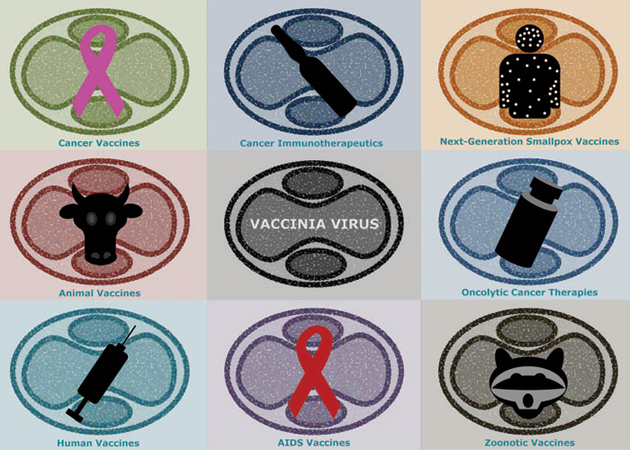
The question facing pathobiologist Paulo Verardi is not whether vaccines are effective in controlling disease – they are – it is how they can be made both highly safe and highly effective at the same time.
In an article published in the Proceedings of the National Academy of Sciences (PNAS), Verardi, an assistant professor in the Department of Pathobiology and Veterinary Science in the College of Agriculture and Natural Resources, his students, and collaborators at UC Davis describe the development of “SMART” virus vectors for use in vaccines and therapeutics. The acronym SMART stands for Safety Mechanism Assisted by the Repressor of Tetracycline, an antibiotic commonly prescribed to treat bacterial infections.

Verardi, who is also a member of UConn’s Center of Excellence for Vaccine Research, explains, “The most effective vaccines tend to be live replicating viruses, the so-called live attenuated vaccines. Vaccinia virus, which is used as the smallpox vaccine, is a good example. While most vaccines are both safe and effective, those based on live viruses can cause problems in some people, so we designed a safety mechanism that can be activated by the administration of tetracyclines by making minimal genetic modifications to vaccinia virus.”
The researchers created a SMART vaccinia virus that replicates normally to induce protection, but can be turned off in response to antibiotics if the person who has been vaccinated develops complications that are serious enough to require intervention. “We basically made the virus susceptible to antibiotics,” says Verardi.
Concern about smallpox
Due to the success of worldwide vaccination efforts against smallpox, the World Health Organization officially declared the disease eradicated in 1980. However, as Verardi explains, stocks of the smallpox virus are still kept at the Centers for Disease Control and Prevention in Atlanta, Ga., and in Russia, where it was developed as a bioweapon by the former Soviet Union. In addition, there are now concerns about its potential use in bioterrorism.
For this reason, members of the U.S. armed forces and some first responders are routinely vaccinated against smallpox, even though the general population is not. After vaccination, a small blister forms at the injection site, which is usually the upper arm. This is followed by a pustule that scabs over and falls off a few weeks later. The end result is a small scar on the arm, called the ‘take’, which indicates that an individual is fully protected.

Sometimes, those receiving the vaccine do not realize they are at risk for adverse reactions. They may be under immunosuppressive drug therapy, have an undiagnosed HIV-AIDS infection, or a skin condition such as eczema – another contraindication that compromises their ability to clear the infection. In addition, a family member with any of these conditions (particularly children with eczema) could also be adversely affected if they came into contact with the vaccination site of the person who was inoculated.
“What happens in very rare cases,” Verardi says, “is that individuals start to show signs of severe illness after vaccination that may lead to death. People with eczema can develop extensive skin lesions, and others can develop an ongoing infection of the skin with progressive tissue destruction or even encephalitis.”
While Verardi stresses that these instances are uncommon, using a SMART smallpox vaccine would be an important advance. The SMART vaccines would still be effective and provide the intended protection, but if unforeseen side effects occur, the simple administration of tetracycline antibiotics would stop viral replication and the progression of the complication.
In this study, funded by the National Institutes of Health, the SMART vaccine concept was tested in mice with severe combined immunodeficiency (SCID) that are highly susceptible to vaccinia virus infection. The SCID mice were only protected from lethal infection when treated with antibiotics.
Other vaccines and therapies
Vaccinia virus has a number of properties that make it a valuable tool beyond use as a smallpox vaccine. Unlike many live viruses, it is thermally stable, has the ability to elicit strong immune responses, is easy to propagate, and is not oncogenic (cancer-causing). Vaccinia virus is used in the development of other vaccines, including AIDS and cancer vaccines for humans, and rabies and fertility control vaccines for wildlife.
Vaccinia virus is also being tested as a therapeutic vector to stimulate immune responses to cancers (immunotherapies) and kill cancer cells (oncolytic therapies), with promising results. Verardi anticipates that the new SMART technology will help advance such vaccine and therapeutic vectors by increasing the safety of vaccinia virus. He and his lab are already developing oncolytic therapeutic vectors and a new generation of the smallpox vaccine, and plan to test their efficacy shortly.
In the PNAS article, Verardi and his co-authors say, “This built-in safety mechanism has the potential to positively impact the development of next generation, replication-competent VACV vaccines and therapeutic vectors, possibly allowing treatment of complications from vaccination or therapy to be as simple as standard tetracycline antibiotic treatment.”



